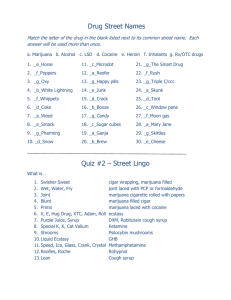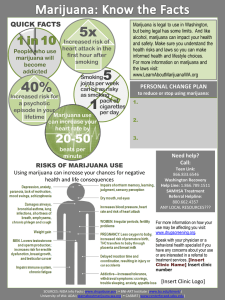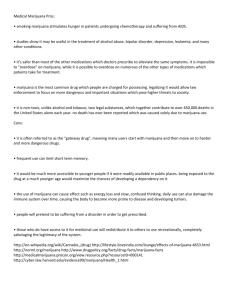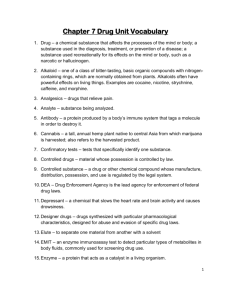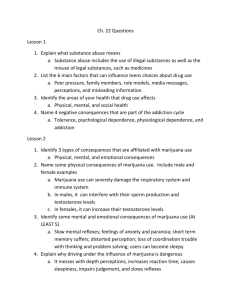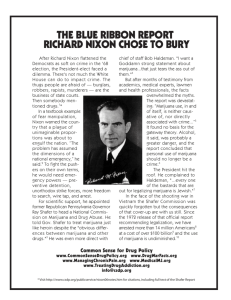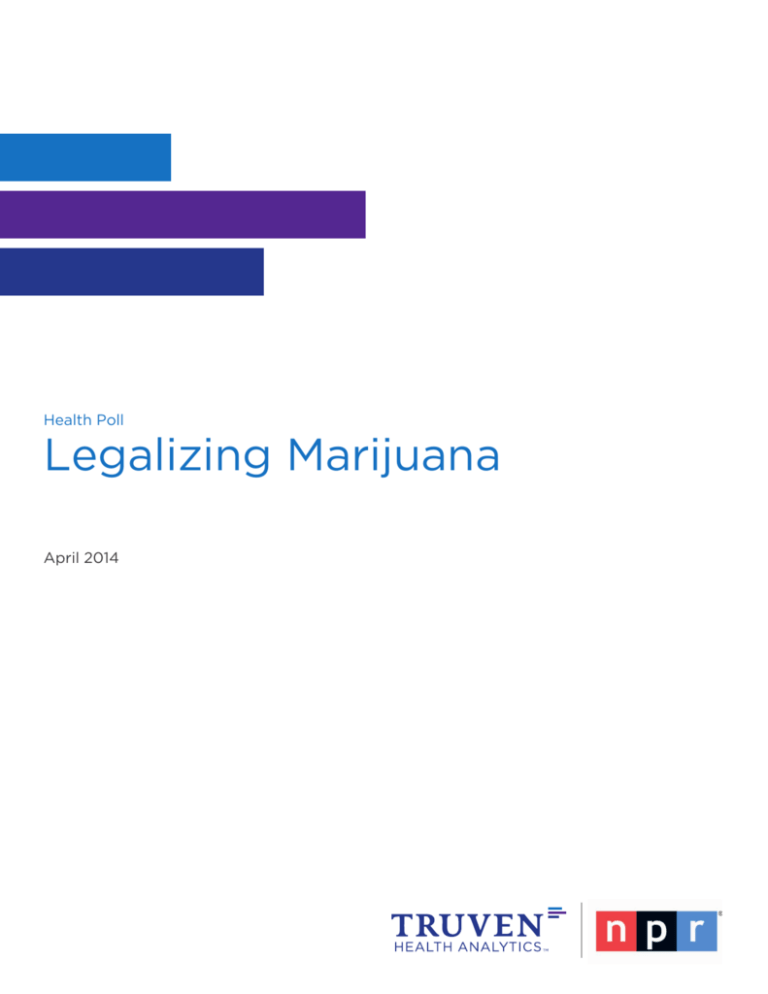
Health Poll
Legalizing Marijuana
April 2014
Executive
Summary
SURVEY OVERVIEW
Each month, the Truven Health
AnalyticsTM-NPR Health Poll
surveys approximately 3,000
Americans to gauge attitudes
and opinions on a wide range of
healthcare issues. Poll results are
reported by NPR’s Scott Hensley
on the health blog Shots (http://
www.npr.org/blogs/health/) and
on air.
Complete survey results are
posted here: www.truvenhealth.
com/truven_insights/npr_poll.aspx
NPR’s reports on the findings
are archived here: www.npr.
org/templates/archives/archive.
php?thingId=137038712&ps=sh_
sttag
The Truven Health AnalyticsNPR Health Poll is powered by
the Truven Health Analytics
PULSE™ Healthcare Survey, an
independently funded telephone
poll that collects information
from more than 100,000 U.S.
households annually.
The results depicted here
represent responses from 3,010
survey participants interviewed
from March 4–17, 2014. The margin
of error is +/- 1.8 percent.
The survey asked for respondents’ opinions on
aspects of legalizing marijuana.
Following were the results:
§§ Seventy-eight percent of respondents indicated that marijuana should be legalized
for medical purposes. The rate tends to decline with increasing age, with the lowest
rate (60 percent) among the Silent Generation.
§§ Less than half (43 percent) of all respondents think that marijuana should be
legalized for recreational purposes. 60 percent of respondents with a household
income of $100,000 or more think marijuana should be legalized for recreational
purposes.
§§ While only 14 percent of the Silent Generation thinks that marijuana should be
legalized for recreational purposes, this group is least likely (81 percent) to think
there should be age restrictions on such use.
§§ Most (91 percent) respondents believe there should be age restrictions for
recreational use of marijuana.
§§ Half (51 percent) of all respondents believe there should be age restrictions
associated with medical use of marijuana. The rate tends to decrease with increasing
age and also with increasing level of education.
§§ There is widespread agreement (90 percent) that healthcare providers should
be responsible for providing education to patients using marijuana for medical
purposes, although again the Silent Generation is least likely (81 percent) to agree.
§§ 22 percent of respondents cite impairment of senses as their most significant concern
regarding the use of marijuana. Addiction, access by minors, or abuse were cited by
a total of 30 percent as their most significant concerns.
Survey Data
Responses in BOLD are statistically significant.
Currently, almost 20 states allow the use of marijuana for medical purposes and two
states have recently legalized the recreational use of marijuana.
Question 1
Do you believe marijuana should be legalized for medical purposes?
a. Yes
b. No
Age
Yes
No
<35
82.1%
17.9%
35 — 64
81.0%
19.0%
65+
63.9%
36.1%
Total
78.2%
21.8%
HS or Less
73.7%
26.3%
Some College/Assoc
80.6%
19.4%
College+
79.3%
20.7%
Total
78.2%
21.8%
60.2%
39.8%
Baby Boomers
77.1%
22.9%
Generation X
81.5%
18.5%
Millennials
83.1%
16.9%
Total
78.2%
21.8%
Education
Generation
Silent Generation
Income
<$25k
78.2%
21.8%
$25k - $49.9k
79.4%
20.6%
$50k - $99.9k
78.2%
21.8%
$100k+
84.6%
15.4%
Total
78.2%
21.8%
Question 2
Do you believe marijuana should be legalized for recreational purposes?
a. Yes
b. No
Age
Yes
No
<35
54.6%
45.4%
35 - 64
44.6%
55.4%
65+
18.9%
81.1%
Total
42.7%
57.3%
38.5%
61.5%
Some College/Assoc
45.1%
54.9%
College+
43.7%
56.3%
Total
42.7%
57.3%
Education
HS or Less
Generation
Silent Generation
13.8%
86.2%
Baby Boomers
35.6%
64.4%
Generation X
49.8%
50.2%
Millennials
55.6%
44.4%
Total
42.7%
57.3%
44.0%
56.0%
Income
<$25k
$25k - $49.9k
42.1%
57.9%
$50k - $99.9k
40.3%
59.7%
$100k+
60.4%
39.6%
Total
42.7%
57.3%
Question 3
If the use of marijuana is legal, should there be age restrictions for medical purposes?
a. Yes
b. No
Age
Yes
No
<35
35 - 64
65+
Total
55.7%
49.1%
48.7%
51.0%
44.3%
50.9%
51.3%
49.0%
Education
HS or Less
Some College/Assoc
College+
Total
57.6%
52.8%
45.3%
51.0%
42.4%
47.2%
54.7%
49.0%
Generation
Silent Generation
Baby Boomers
Generation X
Millennials
Total
51.6%
44.8%
54.5%
53.6%
51.0%
48.4%
55.2%
45.5%
46.4%
49.0%
Income
<$25k
$25k - $49.9k
$50k - $99.9k
$100k+
Total
54.9%
56.3%
47.6%
41.5%
51.0%
45.1%
43.7%
52.4%
58.5%
49.0%
Question 4
If the use of marijuana is legal, should there be age restrictions for recreational
purposes?
a. Yes
b. No
Age
Yes
No
<35
35 - 64
65+
Total
92.1%
92.4%
86.0%
91.1%
7.9%
7.6%
14.0%
8.9%
Education
HS or Less
Some College/Assoc
College+
Total
88.2%
91.1%
93.0%
91.1%
11.8%
8.9%
7.0%
8.9%
Generation
Silent Generation
Baby Boomers
Generation X
Millennials
Total
81.4%
92.7%
92.9%
91.1%
91.1%
18.6%
7.3%
7.1%
8.9%
8.9%
Income
<$25k
$25k - $49.9k
$50k - $99.9k
$100k+
Total
90.7%
90.9%
93.0%
93.6%
91.1%
9.3%
9.1%
7.0%
6.4%
8.9%
Question 5
Similar to other prescription drugs, should healthcare providers be responsible for
providing education to patients intending to purchase marijuana for medical use?
a. Yes
b. No
Age
Yes
No
<35
35 - 64
65+
Total
92.4%
91.2%
84.7%
90.4%
7.6%
8.8%
15.3%
9.6%
Education
HS or Less
Some College/Assoc
College+
Total
86.1%
92.4%
91.6%
90.4%
13.9%
7.6%
8.4%
9.6%
Generation
Silent Generation
Baby Boomers
Generation X
Millennials
Total
81.2%
89.8%
92.9%
91.7%
90.4%
18.8%
10.2%
7.1%
8.3%
9.6%
Income
<$25k
$25k - $49.9k
$50k - $99.9k
$100k+
Total
92.9%
89.0%
93.8%
88.9%
90.4%
7.1%
11.0%
6.2%
11.1%
9.6%
Question 6
In your opinion, what is the most significant concern associated with the use of
marijuana?
a. Addiction
b. Leads to use of other drugs (gateway drug)
c. Causes disease
d. Social stigma
e. Impairment of senses
f. Increased risk of minors having access
g. No significant concerns
h. Abuse
i. Long term effects
j. Other
Age
<35
35 - 64
65+
Total
Education
HS or Less
Some College/Assoc
College+
Total
Generation
Silent Generation
Baby Boomers
Generation X
Millennials
Total
Income
<$25k
$25k - $49.9k
$50k - $99.9k
$100k+
Total
Addiction Gateway Disease
15.3%
10.4%
5.9%
14.1%
11.4%
6.5%
20.0%
17.1%
4.4%
15.5%
12.1%
5.9%
Stigma
4.1%
3.5%
1.4%
3.3%
Impairment
19.6%
22.6%
24.9%
22.2%
Minors Other
8.6% 9.4%
8.4% 13.0%
6.5% 11.4%
8.1% 11.7%
No
Concerns
20.2%
14.0%
7.0%
14.6%
Abuse
5.8%
6.1%
6.6%
6.1%
Long
Term
Effects
0.6%
0.3%
0.7%
0.5%
16.7%
14.3%
15.7%
15.5%
12.1%
9.8%
13.9%
12.1%
5.2%
6.1%
6.3%
5.9%
2.1%
3.0%
4.2%
3.3%
14.8%
23.4%
25.6%
22.2%
10.5%
9.4%
5.7%
8.1%
11.1%
11.7%
12.0%
11.7%
21.9%
16.9%
8.5%
14.6%
5.6%
5.3%
7.0%
6.1%
0.0%
0.1%
1.1%
0.5%
23.4%
11.8%
16.3%
15.5%
15.5%
16.1%
12.7%
12.2%
9.7%
12.1%
4.3%
6.3%
5.5%
6.8%
5.9%
1.2%
2.1%
4.5%
4.0%
3.3%
22.4%
26.3%
21.2%
18.4%
22.2%
8.1%
7.8%
8.7%
7.7%
8.1%
12.4%
13.9%
11.5%
8.9%
11.7%
7.1%
12.4%
13.7%
21.7%
14.6%
4.5%
6.0%
6.4%
6.6%
6.1%
0.6%
0.6%
0.1%
0.7%
0.5%
15.3%
14.1%
16.3%
9.2%
15.5%
10.3%
13.7%
13.5%
11.0%
12.1%
6.1%
4.6%
6.9%
4.6%
5.9%
2.7%
4.3%
3.2%
3.7%
3.3%
17.3%
22.7%
25.5%
24.9%
22.2%
10.6%
7.6%
7.0%
8.8%
8.1%
8.9%
11.4%
11.4%
17.7%
11.7%
21.2%
15.3%
11.5%
9.7%
14.6%
7.4%
6.3%
3.7%
9.5%
6.1%
0.2%
0.1%
1.0%
0.9%
0.5%
©2014 Truven Health Analytics Inc. All rights reserved.

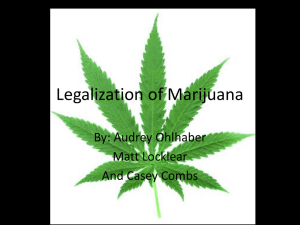
![[H1]Researching Society with MicroCase Online](http://s3.studylib.net/store/data/007737973_2-9d35b9e42208c660471ccaa373bd3b78-300x300.png)
